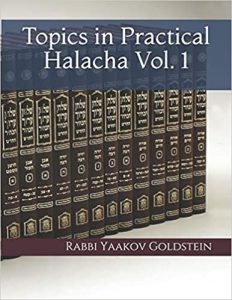
*As an Amazon Associate I earn from qualifying purchases.
May one have engravings, drawings and pictures in a shul, such as by the wall, Paroches or Aron Kodesh?[1]
All forms that are forbidden to be made, as explained in the summary, are forbidden to be made as a sculpture or picture on the Aron Kodesh, Paroches or walls of the Shul. Some Poskim[2] however rule, that although one may not make the forbidden forms, one may own a Paroches that has forbidden forms, and placing it in Shul does not transgress the above prohibition of owning the forbidden forms.[3] Other Poskim[4] however forbid having such items in shul and require the removal of the forbidden forms in event that it was erected in Shul.[5] Furthermore, some Poskim[6] rule that this applies even to non-forbidden forms, such as animals, and birds, in order so it does not appear like one is bowing down to them. Other Poskim[7] negate this stringency. According to all, it is proper to avoid placing any pictures on the walls of a Shul which are opposite the eyes of the people praying, due to it being a potential distraction to the concentration of the worshipers.[8] The same applies regarding pictures on the Paroches.[9] Nonetheless, if the congregation is already used to these drawings, then it is not necessary to avoid them.[10] In all cases, it is forbidden to have in a Shul pictures of items that are known to be used for idolatry, even if this specific item was never worshipped.[11]
Practical custom: Practically, many Shuls of previous generations were accustomed to have pictures of animals and birds on the walls or Heichal, with some Rabbanim defending the custom, and others protesting against it.
Pictures of Tzaddikim hanging in Shul:[12] It is forbidden to place pictures of people in a Shul, even of Tzaddikim. This applies to anywhere within the sanctuary of the Shul.
___________________________________________[1] See Darkei Teshuvah 141:48; Piskeiy Teshuvos 90:29; Having pictures of items in a Shul enters into three Halachic issues: 1) Prohibition of making or owning forbidden forms. 2) It looks like one is bowing down to the item. 3) It distracts the people praying.
[2] Kneses Yechezkal 13, brought in Pischeiy Teshuvah 141:6
[3] The reason: As a) If it is a drawing and not an engraving, some Poskim rule it is permitted by all forms. b) The public may own a forbidden form that was engraved. [ibid]
[4] Elya Raba 90:27; Mabit 1:30, brought in Darkei Teshuvah 141:44; P”M 90 M”Z 6; Divrei Yosef 8, brought in Pischeiy Teshuvah 141:8; Pischeiy Teshuvah ibid concludes that it is best to be stringent; Beis David Hasefaradi Y.D. 5, brought in Darkei Teshuvah 141:44; See Zera Emes 3:105
[5] The reason: As Chashad applies in a Shul which is a place designated for worship. [ibid]
[6] Taz 141:14 in name of Hagahos Ashri, in name of Rabbeinu Elyakim; Avkas Rochel 63 that the words of Rav Elyakim is Ikkur [unlike his ruling in Beis Yosef]; Maharit 2:35 regarding the protruding figure of a lion on a stone of the Heichal, brought in Beis Lechem Yehuda 141; Radak; Maharam Padva 65; Radbaz 4:1178; Birkeiy Yosef 141; See Beis Lechem Yehuda 141:11 who writes that perhaps this only applies by the Mizrach of the Shul which people face and bow towards. The same would apply to any wall that people bow towards. Beis Lechem Yehuda ibid concludes that many Shuls are lenient in this matter and they do not have upon whom to rely; Darkei Teshuvah 141:48 in name of Maharash Heller of Tzefas; Beis Shlomo 1:128; Dvar Moshe 1:8; Beis David Hasefaradi 5; Neta Shoreik 46; Aruch Hashulchan 90:28; See Piskeiy Teshuvos 90:29
Other opinions: The Beis Yosef 141 negates this opinion of Rav Elyakim, however in his Shut Avkas Rochel he later rules like him. [Birkeiy Yosef 141]
[7] Beis Yosef 141; Machaneh Chaim Y.D. 2:29 defends the practice and concludes G-d forbid to state that the previous generations were transgressors”; Igros Moshe Y.D. 2:55; See Darkei Teshuvah and Piskeiy Teshuvos ibid; Implication of Admur 90:22-23 who never makes mention of any reason of “appearing like one is bowing” in any of the restrictions he mentions regarding Davening behind a person or ones Rebbe, or opposite a picture, and explicitly permits it if it is above ones head, as rules the M”A 90:37; Implication of Admur 90:21 and Michaber 90:22 that from the letter of the law there is no prohibition against Davening behind a person. M”B 90:69 that when there is no other choice, one may even initially Daven opposite a person
[8] Admur 90:22; M”A 90:37 “Is forbidden”
[9] Admur ibid
[10] See Kneses Yechezkal 13, brought in Pischeiy Teshuvah 141:6
[11] Admur ibid regarding Divrei Tiflus; Rama 90:23; See Pischeiy Teshuvah ibid
[12] See Taz ibid; Divrei Malkiel 6:2; Piskeiy Teshuvos 90:29; See Tzitz Eliezer 19:8; Or Letziyon 2:87-11


 Donate
Donate
Leave A Comment?
You must be logged in to post a comment.